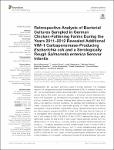Retrospective Analysis of Bacterial Cultures Sampled in German Chicken-Fattening Farms During the Years 2011–2012 Revealed Additional VIM-1 Carbapenemase-Producing Escherichia coli and a Serologically Rough Salmonella enterica Serovar Infantis
Roschanski, Nicole
Fischer, Jennie
Falgenhauer, Linda
Pietsch, Michael
Guenther, Sebastian
Kreienbrock, Lothar
Chakraborty, Trinad
Pfeifer, Yvonne
Guerra, Beatriz
Roesler, Uwe H.
Carbapenems are last-resort antibiotics used in human medicine. The increased detection of carbapenem-resistant Enterobacteriaceae (CRE) is therefore worrying. In 2011 we reported the first livestock-associated VIM-1-producing Salmonella (S.) enterica serovar Infantis (R3) isolate from dust, sampled in a German chicken fattening farm. Due to this observation we retrospectively investigated more than 536 stored bacterial cultures, isolated from 45 chicken fattening farms during the years 2011 and 2012. After a non-selective overnight incubation, the bacteria were transferred to selective media. Escherichia (E.) coli and Salmonella growing on these media were further investigated, including antibiotic susceptibility testing, carbapenemase gene screening and whole genome sequencing (WGS). In total, four CRE were found in three out of 45 investigated farms: Besides R3, one additional Salmonella (G-336-1a) as well as two E. coli isolates (G-336-2, G-268-2). All but G-268-2 harbored the blaVIM-1 gene. Salmonella isolates R3 and G-336-1 were closely related although derived from two different farms. All three blaVIM-1-encoding isolates possessed identical plasmids and the blaVIM-1- containing transposon showed mobility at least in vitro. In isolate G-268-2, the AmpC beta-lactamase gene blaCMY-2 but no known carbapenemase gene was identified. However, a transfer of the phenotypic resistance was possible. Furthermore, G-268-2 contained the mcr-1 gene, combining phenotypical carbapenem- as well as colistin resistance in one isolate. Carbapenem-resistant Enterobacteriaceae have been found in three out of 45 investigated chicken flocks. This finding is alarming and emphasizes the importance of intervention strategies to contain the environmental spread of resistant bacteria in animals and humans.
No license information

